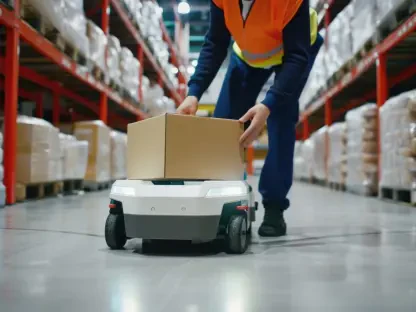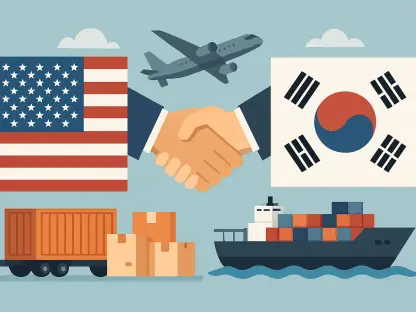In an era where air cargo underpins global trade, from delivering critical healthcare supplies to fueling e-commerce booms, the environmental toll of aviation looms large, demanding urgent action. The aviation sector accounts for a significant chunk of global emissions, and cargo operations are no exception, facing mounting pressure to decarbonize. Enter sustainable aviation fuel (SAF), a promising alternative to traditional jet fuel, which FedEx has begun integrating into its operations at major hubs like Chicago O’Hare and Miami International Airports. This roundup dives into diverse perspectives from industry stakeholders, analysts, and logistics experts to explore how FedEx is pioneering SAF in cargo operations, the challenges it faces, and the broader implications for the industry.
Diverse Voices on FedEx’s SAF Initiative in Cargo Operations
Strategic Hub Selection: A Calculated Move or Risky Bet?
Industry observers have noted that FedEx’s choice to launch SAF at Chicago O’Hare and Miami International Airports reflects a deliberate strategy to test the fuel in high-stakes environments. These hubs are pivotal, with O’Hare acting as a central distribution point for inland U.S. cargo and Miami serving as a key gateway to Latin American markets. Many logistics analysts praise this approach, arguing that focusing on high-traffic nodes provides critical data on SAF performance under intense operational demands, potentially paving the way for broader adoption.
However, not all views align on the immediate benefits. Some supply chain consultants caution that prioritizing such busy hubs could strain operational efficiency if SAF supply chains falter or costs spiral. They suggest that smaller, less critical airports might have offered a safer testing ground to iron out logistical kinks. This divergence highlights a tension between bold innovation and pragmatic caution, with FedEx’s rollout seen as both a potential game-changer and a gamble in equal measure.
Economic Hurdles: Can SAF Costs Be Justified?
On the economic front, opinions vary widely about SAF’s steep price tag compared to conventional jet fuel. Industry reports consistently point out that SAF remains a small fraction of the aviation fuel market, with production costs often double or triple those of traditional options. Many fuel market analysts commend FedEx for absorbing these costs at two major hubs, viewing it as a commitment to long-term sustainability goals, such as achieving 30% alternative fuel usage by 2030.
Contrasting this optimism, some financial experts in the logistics sector express skepticism about the scalability of such investments. They argue that without significant government subsidies or a rapid drop in SAF production costs, widespread adoption could burden cargo operators with unsustainable expenses. This split in perspective underscores a broader debate: whether early adopters like FedEx will inspire cost reductions through demand or struggle under the weight of pioneering an unproven market.
Scaling SAF Production: Hopeful Forecasts vs. Stark Realities
The future of SAF production elicits both enthusiasm and concern among industry players. Renewable energy specialists highlight a surge in U.S. refineries and startups working to boost SAF output, projecting a notable increase in supply over the next few years, potentially from 2025 to 2027. They see FedEx’s initiative as a catalyst that could encourage producers to prioritize aviation over other sectors, given the company’s influence in air cargo.
On the flip side, some aviation policy analysts warn that production timelines may not align with ambitious corporate targets. They note regional disparities in SAF readiness, with Europe often outpacing the U.S. in infrastructure and incentives, which could limit FedEx’s expansion plans to other hubs. This contrast paints a picture of an industry at a crossroads, where technological progress offers hope, but systemic barriers demand patience and strategic alignment.
Customer Demand as a Driving Force for Green Logistics
Shifting to market dynamics, many retail and manufacturing leaders emphasize that customer expectations are pushing companies like FedEx toward SAF. Large corporations increasingly demand low-carbon shipping options as part of their sustainability commitments, a trend that logistics consultants see as a powerful motivator for FedEx’s actions. This alignment with client priorities is often cited as a smart move to retain a competitive edge in a crowded market.
Yet, some smaller cargo operators argue that this customer-driven shift risks sidelining businesses unable to afford SAF’s costs, potentially widening the gap between industry giants and smaller players. They advocate for collaborative models where larger firms like FedEx share insights or resources to democratize access to greener fuels. This spectrum of opinions reveals how market forces can both accelerate and complicate the transition to sustainable logistics.
Key Takeaways from FedEx’s Early SAF Journey
Drawing from these varied insights, several lessons emerge about FedEx’s foray into sustainable aviation fuel. Logistics strategists often agree that starting at high-impact hubs like Chicago and Miami offers invaluable real-world testing, though opinions differ on whether the risks outweigh the rewards. There’s also a consensus that economic barriers, particularly SAF’s cost and limited availability, remain a formidable challenge, with some advocating for policy support to level the playing field.
Another recurring theme is the role of production scalability, where optimism about future supply growth is tempered by concerns over timing and regional disparities. Finally, customer demand stands out as a unifying driver, though its impact on industry equity sparks debate. These perspectives collectively frame FedEx’s initiative as a bold experiment with far-reaching potential, provided hurdles are navigated with care.
Reflecting on the Path Forward for Sustainable Air Cargo
Looking back, the discussions around FedEx’s adoption of sustainable aviation fuel at pivotal cargo hubs revealed a complex interplay of innovation, economics, and market forces. Industry voices largely agreed on the significance of this step, even as they debated its immediate feasibility and long-term impact. The challenges of cost and supply stood as persistent obstacles, while customer expectations emerged as a compelling push toward greener practices.
Moving ahead, stakeholders can take actionable steps by fostering partnerships between cargo operators and SAF producers to secure reliable supply chains. Governments and industry bodies might consider incentives to offset costs, ensuring smaller players aren’t left behind. For businesses reliant on air cargo, advocating for sustainability clauses in contracts could amplify demand for eco-friendly options. As production capabilities evolve, these collective efforts could transform FedEx’s early gamble into a lasting blueprint for decarbonizing air logistics.









